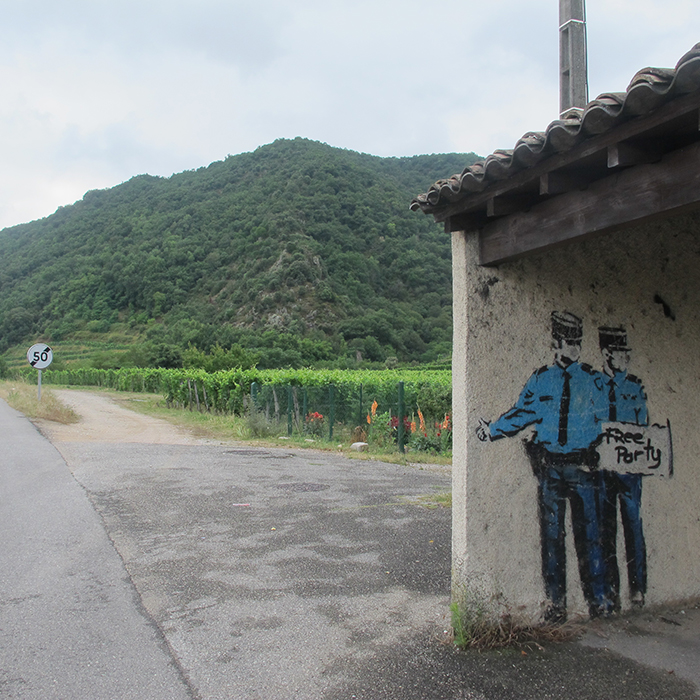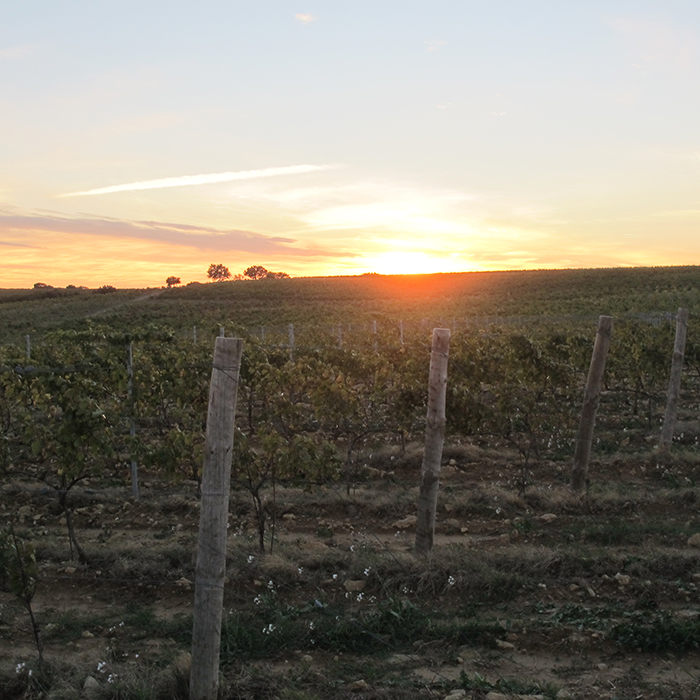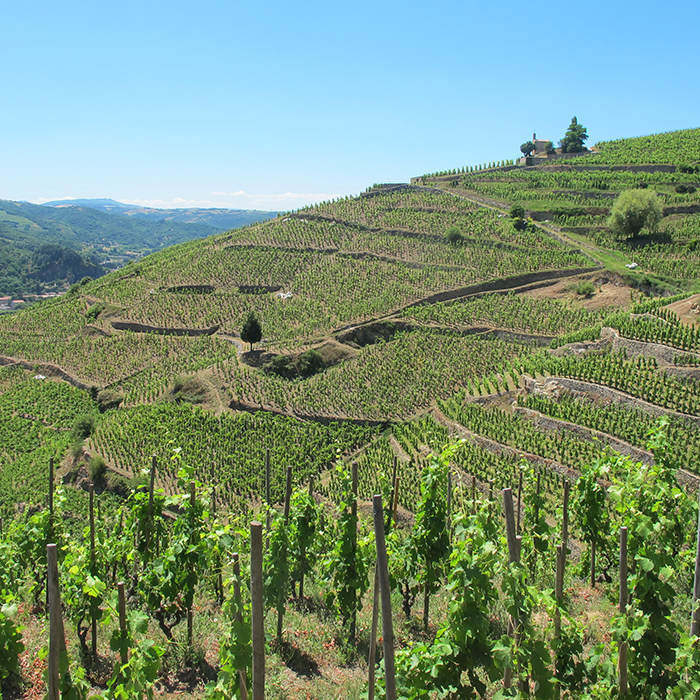Postcards from the Rhône
Author: Guest Blogger

Every year I produce an in-depth report on the new Rhône vintage, so I spend two weeks tasting over a thousand wines and visiting dozens of estates. Over the years I’ve got to know the region fairly well, so here are some tips on places to eat, stay and visit. I normally go alone, but this year I was joined by Richard Hemming MW.
When is the best time to visit? Anytime between May and September. Don’t leave it as late as I do – October is cool, and often rainy, but at this time of year there are some big positives: the winemakers have their fruit safely indoors (apart from Château Rayas perhaps, who always harvests late) and can spare some time to talk. And, if I really time it right and fly home on the evening of the 5th of November, I can watch the fireworks glitter across London as I land.
A week in the Southern Rhône
We flew into Marseille airport on a cool Sunday October afternoon. It’s always a tense moment as you weave among the parked hire cars, hoping you don’t end up with a Proton Savvy. It’s even more tense as you figure out how to get the sound system working, wondering what each other’s music tastes will be like. Thankfully Richard and I like exactly the same stuff. I press shuffle on ‘Now That’s What I Call Romantic Pan Pipe Moods Vol. III’ and off we drive to Châteauneuf-du-Pape.
It might have a big reputation but Châteauneuf is a surprisingly small town; a day is enough to explore the ancient streets that spread down from the feet of the ruined Château itself. It has one medium-sized hotel (La Mère Germaine), one excellent restaurant (Le Verger des Papes), another decent mid-week option (La Maisouneta), and a few cafés where you can grab a coffee or a beer. The unmissable Table de Sorgues is a 20-minute drive away; Restaurant Les Fines Roches a little closer and more formal yet. The Wine B&B is my favourite place to stay; homely, welcoming, serves good breakfasts, and owner Danièle (a former top sommelier and restaurateur) has an in-depth knowledge of the surrounding area.
There are dozens of wineries worth visiting in and around the town, but Clos des Papes, La Vieille Julienne, Domaine du Banneret, Le Vieux Donjon, Domaine de Beaurenard, Domaine la Barroche, Le Clos du Caillou, Domaine de Marcoux, Château la Nerthe and Domaine de la Solitude are all worth a look. Some are more geared up for visits than others, so don’t forget to make an appointment beforehand. If you’re just looking for a selection of bottles to take home, pop into the Vinadéa boutique which is managed by the local Maison des Vins. Three days of solid tastings and visits proved the rumours true – 2016 really is an exceptional vintage in Châteauneuf – and, so it transpired, for the rest of the Southern Rhône – structured, concentrated wines but without heaviness.
From here, we drove further south to Avignon – the perfect base from which to explore the rest of the Southern Rhône. It’s a beautiful, atmospheric city and has enough to keep you busy for several days: great clothes shops, wine shops (Le Vin Devant Soi, Liquid), wine bars (L’Ampelos), places to eat (La Fourchette, Avenio, L’Essentiel, Maison Ripert, Le CO2), not to mention the impressive Palais des Papes. Outside Avignon there are plenty more towns, villages and vineyards to explore. Gigondas, Beaumes-de-Venise and Carpentras make for particularly worthwhile day trips.
After spending several days tasting all the other appellations of the Southern Rhône it was time to move on. We jumped in the Proton Savvy, turned up the volume on ‘Meatloaf – The Hip Hop Years’ and headed north…

A week in the Northern Rhône
After a rewarding week’s visits and tastings in the Southern Rhône, Richard and I drove north to Tain L’Hermitage. N.B it is important not to arrive here too too late. Ten years ago, with more youthful enthusiasm, two colleagues and I arrived in Tain at 9.30pm and went out in search of something to eat. None of the restaurants that remained open would serve us – it was simply “trop tard”, they explained with a shrug. Eventually we found a pizza joint; the chef wouldn’t serve us here either (was it something we said?!), but the waitress said she could at least make us desserts. So, for dinner that night we had ice cream to start, followed by crème caramel, and we finished with chocolate mousse. Just as well I have a sweet tooth.
Tain has done a lot to make itself more welcoming to travellers and tourist since then, and is now well worth a visit. It’s a small town with a busy road running through it, but now has several bars, restaurants and places to stay. The best restaurant is Le Mangevins, owned by a young wine-loving couple who have a light touch in the kitchen. Le Quai on the river is also good; it’s owned by local celebrity chef Michel Chabran; his Michelin-starred, self-titled restaurant is even better, and just a 15-minute drive away.
Winemaking domaines are usually even smaller in the North than in the South, so make sure to always call before you visit; try Domaine Combier or Domaine Fayolle Fils et Fille. Chapoutier and Cave de Tain both have busy boutiques open seven days a week, and Delas is due to open a €5m visitor centre this summer. Fellow chocolate lovers – do not miss the Valrhona visitor centre and shop.
Tournon, just over the river by footbridge, is a larger and prettier town than Tain. Hôtel de la Villeon is the best place to stay; wander down to the waterfront and buy some wine at Les Caves des Vignerons de l’Ardèche and Cave Balthazar. For dinner, Le Chaudron serves classic local dishes and has a good wine list.
There’s not much to see in Cornas, but it’s worth taking a look around pretty Saint-Péray one morning; have lunch at La Ruche for contemporary cuisine and a good selection of local wines. Then drive up to Côte-Rôtie; an hour by motorway, but if you have an extra half-hour to spare, follow the D86 up the west bank of the Rhône for stunning vineyard scenes over Saint-Joseph.
Condrieu and Côte-Rôtie are even less advanced than Tain and Tournon in terms of wine tourism; they are small, working towns – but still a must for Rhône-lovers. There aren’t many good places to stay or eat, but Domaine de Clairefontaine (or their neighbouring ‘Cottage’) on the other side of the river are good options for both. In Condrieu, Le Beau Rivage is a pleasant riverside dining option. In Ampuis, I always visit the ever-reliable Bistrot de Sérine – this time for lunch with Christine Vernay and Paul Amsellem of Domaine Georges Vernay. Their Condrieus are hard to beat; pay them a visit if you get the chance. There are plenty of other estates around Ampuis that accept visitors with prior notice; try Domaine de Bonserine, Domaine Jasmin, Domaine Barge, Cave Yves Cuilleron and Vignobles Levet.
A lot of noise has been made about the quality of the 2016 vintage in the Southern Rhône, and rightly so – it’s an exceptional year. But tasting in the Northern Rhône made it clear that this is a lovely vintage here too; the wines don’t typically display the same concentration and intensity, but they are fresh, balanced, and have a wonderful drinkability. If you’re not planning a visit, you should at least be putting some 2016s in your cellar.

Matt Walls is a contributing editor at Decanter magazine, and is regional chair for the Rhône at the Decanter World Wine Awards. His selection of the 300 most notable wines of the 2016 vintage can be found here.
To browse our 2016 Rhône en primeur offer, click here.


